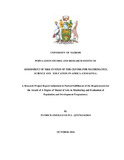| dc.description.abstract | The main objective of this research was to determine the status of the CEMASTEA M&E system and its contributions towards the improvement of the programme. The assessment targeted at: Establish the level to which the system meets the required standards; revealing strengths and gaps identified after the investigation; and determining how its products have been used to improve the CEMASTEA programmes.
The assessment applied a cross-sectional design which was the most convenient for this research and was descriptive in nature. There was use of mixed-methods approach to collect and process quantitative data. Cross-sectional research design used allowed for description of the current CEMASTEA M&E system and helped to reveal strengths and gaps which were required for the realization of research objectives. The assessment focused on the CEMASTEA headquarters offices in Nairobi with a sample size of 20 out of 60 staff members.
Data was collected through document review, questionnaires and discussions and eventually analyzed quantitatively to produce the result. The study was informed by the 12 domains recommended for the Participatory M&E System based on the Organizing Framework for the 12 Components by UNAIDS (2008).
The discussions of the results are integrated with the findings. Also integrated with the findings and discussions are relevant M&E issues that arose during the assessment. They are presented as areas that supported the effective implementation of INSET programme and therefore areas that can be capitalised on as well as areas that need improvement. Every effort was made to give an overall picture of the findings. The key strengths of the system include: inventory of research studies, guidance on appropriate monitoring and evaluation standards, forum for information dissemination, use of standardized data collection tools, presence of M&E databases to track progress, continuous data analysis and use of research and evaluations to improve programme.
xiii
In conclusion it is evident that CEMASTEA M&E system is a good case worth sharing. At 56 percent, the M&E system is was rated „moderate‟, with areas for improvement highlighted. In terms of practice, a lot is taking place as far as M&E is concerned notably, in data quality systems, data analysis and use and evaluation. However, other components need strengthening with critical focus on documentation and data verification. The ongoing process of reviewing the M&E plan should directly address the documentation aspect. With the emphasis of continuous management support, resource allocation and assessment for improvement, CEMASTEA‟s M&E system can be an exemplary system for adoption by other institutions. | en_US |

